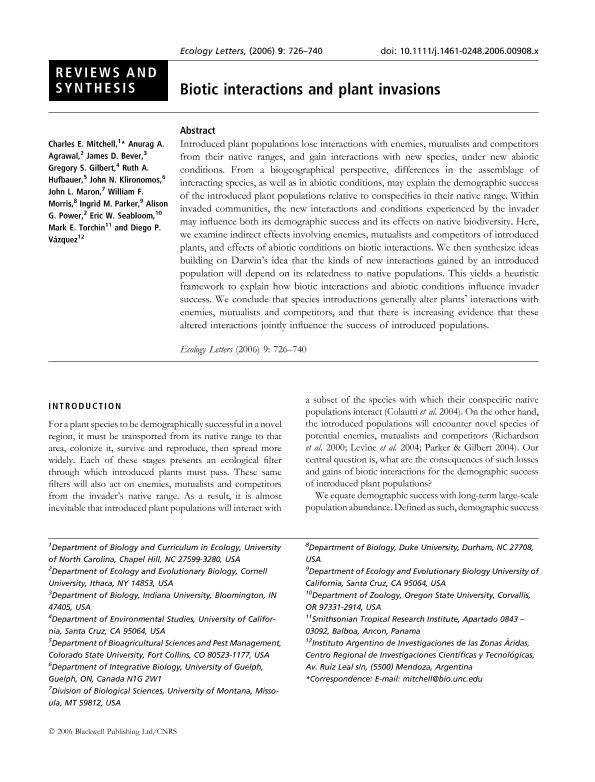Artículo
Biotic interactions and plant invasions
Mitchell, Charles E.; Agrawal, Anurag A.; Bever, James D.; Gilbert, Gregory S.; Hufbauer, Ruth A.; Klironomos, John N.; Maron, John L.; Morris, William F.; Parker, Ingrid M.; Power, Alison G.; Seabloom, Eric W.; Torchin, Mark E.; Vazquez, Diego P.

Fecha de publicación:
06/2006
Editorial:
Wiley Blackwell Publishing, Inc
Revista:
Ecology Letters
ISSN:
1461-023X
e-ISSN:
1461-0248
Idioma:
Inglés
Tipo de recurso:
Artículo publicado
Clasificación temática:
Resumen
Introduced plant populations lose interactions with enemies, mutualists and competitors from their native ranges, and gain interactions with new species, under new abiotic conditions. From a biogeographical perspective, differences in the assemblage of interacting species, as well as in abiotic conditions, may explain the demographic success of the introduced plant populations relative to conspecifics in their native range. Within invaded communities, the new interactions and conditions experienced by the invader may influence both its demographic success and its effects on native biodiversity. Here, we examine indirect effects involving enemies, mutualists and competitors of introduced plants, and effects of abiotic conditions on biotic interactions. We then synthesize ideas building on Darwin's idea that the kinds of new interactions gained by an introduced population will depend on its relatedness to native populations. This yields a heuristic framework to explain how biotic interactions and abiotic conditions influence invader success. We conclude that species introductions generally alter plants' interactions with enemies, mutualists and competitors, and that there is increasing evidence that these altered interactions jointly influence the success of introduced populations.
Archivos asociados
Licencia
Identificadores
Colecciones
Articulos(IADIZA)
Articulos de INST. ARG DE INVEST. DE LAS ZONAS ARIDAS
Articulos de INST. ARG DE INVEST. DE LAS ZONAS ARIDAS
Citación
Mitchell, Charles E.; Agrawal, Anurag A.; Bever, James D.; Gilbert, Gregory S.; Hufbauer, Ruth A.; et al.; Biotic interactions and plant invasions; Wiley Blackwell Publishing, Inc; Ecology Letters; 9; 6; 6-2006; 726-740
Compartir
Altmétricas



